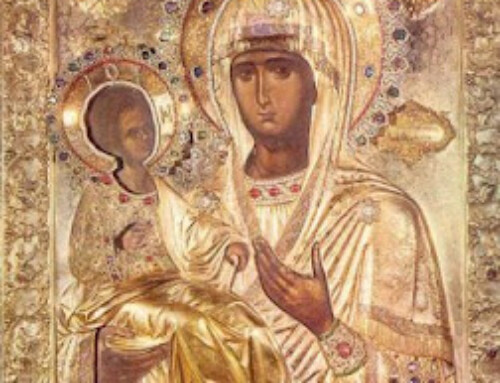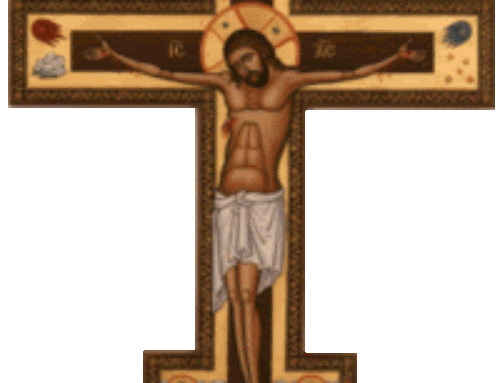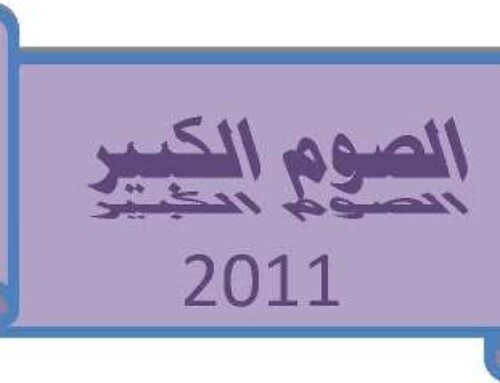Word Magazine February 1989 Page 8-9
THE TRISAGION HYMN
By Dimitri Conomos
In the public and private worship of the Orthodox Church the Trisagion hymn holds a unique place of preeminence. It forms a part of the order in virtually every service — sometimes the requirement is for it to be sung, at other times to be read. How did this simple and short troparion achieve such a distinctive position? What is there in its musical and liturgical tradition that has contributed to its popularity? When we look at its form in the Divine Liturgy, where it appears before the Scriptural lessons, we are confronted by a very curious situation:
Holy God,
Holy Mighty,
Holy Immortal,
Have mercy on us. (3 times)
Glory to the Father, and to the Son, and to the Holy Spirit.
Both now, and ever, and to the ages of ages. Amen.
Holy Immortal have mercy on us.
Holy God,
Holy Mighty,
Holy Immortal,
Have mercy on us.
Why is the hymn initially repeated three times? Why is only the final phrase sung after the small doxology? Why the last (and fourth) repetition? Finally, why was the Trisagion chosen as the hymn to be placed before the Biblical readings? A number of historical factors need to be considered in order to answer these questions. First, it is important to remember that the early Christian liturgy began with the entrance of the clergy (the Small Entrance) and this was immediately followed by the lessons from Scripture. The litanies and antiphons which we now sing before the readings are later additions. Secondly, the Trisagion was not originally designed for the liturgy. It was used in penitential processions which went from one church to another in Constantinople and it was sung as the procession moved along. Certain prayers accompanied its singing (these were said by the clergy when the procession made one or more temporary stops) which entreated God to protect the city from natural disasters, enemy invasions, etc. The final element of the chant, have mercy on us, bears witness to its supplicatory character as does the Prayer of the Trisagion which today is usually said inaudibly by the priest while the choir sings. In fact, according to tradition, the Trisagion hymn was miraculously transmitted to the people of Constantinople during one of these penitential processions when an earthquake had struck the capital early in the fifth century A.D. It is reported that the emperor Theodosios II and the patriarch Proklos gathered with the people outside of the town and prayed to God to have mercy upon them using the familiar invocation Kyrie eleison. Suddenly, a young boy was taken up into the air where he heard the angels sing the hymn. When he returned to earth and told the crowd what the angels were singing, the earthquake subsided as everyone took up the new chant. The memory of this miracle is kept in the Orthodox Church on 25 September.
Subsequently, but before its incorporation into the liturgy, the Trisagion was sung in similar penitential processions throughout the city. It was not simply repeated, however, but was chanted antiphonally with the verses of a psalm which were intoned by a soloist. This may have been Psalm 79 because today, when a bishop celebrates the liturgy, he intercalates verses 14 and 15 of this very psalm (‘Return, we beseech thee, O God of hosts: look down from heaven, and behold, and visit this vine; and the vineyard which Thy right hand hath planted, and the branch that Thou madest strong for thyself’) with the Trisagion. When the procession approached the church at which the Liturgy was to be celebrated, the singers intoned the doxology and the Trisagion was repeated twice more. Then the procession entered the church and the liturgy began with the readings. This partly explains why the hymn is repeated after the doxology. The final phrase, Holy Immortal, have mercy on us, was the concluding element of the refrain (the akroteleution) used by the people in response to the verses of the psalm. Now it stands in curious isolation since its function as a versicle-response has been relinquished.
Now we can appreciate how the Trisagion, which was once used only for special processions, was grafted onto the opening of the ancient Byzantine liturgy. In the sixth century, when the hymn became a fixed part of the service, it was used as the Entrance Chant (Introit) but later it was displaced, probably for the sake of variety, by a number of proper chants appropriate to the day or season. In the form we have today (given above) we can see elements of the opening and ending of the original performance: the original threefold repetition acting as a musical prelude to the verses of the psalm (now suppressed), the closing doxology, and the double repetition at the conclusion. In addition, the position of the Trisagion before the readings recalls its processional function prior to the commencement of the liturgy.
Its striking popularity, however, undoubtedly stems from further considerations. The Trisagion became the subject of dogmatic controversy. At Antioch, the monophysite patriarch Peter the Fuller (c. 470) rejected its Trinitarian basis and recast the text in a form currently used by the Syrian and Coptic monophysites but rejected by the Council in Trullo. Subsequent Orthodox theologians, particularly St. John of Damascus, pseudo-Sophronios and Nicholas Kavasilas, emphasized the Trinitarian nature of the hymn. In a very real sense the Trisagion came to be understood as a common statement of faith, a communal declaration of praise and adoration to the Holy Trinity, an acknowledgement of God’s presence in the liturgy, an incomparably appropriate song to prepare the faithful for readings from God’s written word and, indeed, for any celebration of the church.
How can the music that we sing to this remarkably succinct and powerful text enhance its inner meaning and liturgical function? We have seen that, originally, it was a chant of the people — sung spontaneously and reverently. The tradition would suggest a simple melody, ideal for congregations with little or no musical knowledge. Our earliest written melodies in twelfth and thirteenth-century Russian and Greek musical sources strongly support such a suggestion. All of the ancient tunes adhere to a standard mould; it is as if the scribes who recorded them are preserving to the best of their abilities that exquisite angelic chant which so captivated the early Constantinopolitans. Irrespective of time, place, occasion or style, early Trisagion settings follow a time-honoured scheme and this undoubtedly explains the conspicuous absence of composers’ names beside the settings even though they appear with the music for other liturgical hymns. A valid parallel can be noted in iconography, where the essential features of the saint or event depicted remain constant despite era, provenance or workshop. What is this traditional design? How was it expressed in musical terms? These are crucial questions, the answers to which, if understood properly, can provide a thoroughly positive appreciation of Orthodox musical settings to liturgical hymns, and can offer to choir directors a measure of confident discretion in selecting items for ecclesiastical performance.
Of fundamental importance for early Trisagion musical settings; as for all Orthodox hymnody, is the principle that the text determines both the inner and outer design. The opening two exclamations, Holy God, Holy Mighty, are not only rhetorically and metrically parallel (in Greek and in Slavonic), but also musically. Lines 3 and 4, Holy Immortal, have mercy on us, contribute a small element of variation or development before coming to a cadence that rhymes musically with the phrases of the first two lines. Essentially, what we have is a musical set of rhetorical exclamations —the settings are very simple, carefully phrased, and they avoid any free elaboration which would destroy the parallelism between music and rhetoric. After all, the music is ideally sung by all of the people and its direction and thrust are intended from the outset to obey the inherent dogmatic and poetical impulses of the text.
The most recognizable characteristic of the primitive Trisagion settings is that they are all based on the same musical formula which is firmly established in a g modality — that is, in the old Byzantine and Slavonic musical systems, Tones II, IV, VIII (or IV Plagal), and, occasionally, VI (or Plagal). It must be remembered that the earliest tunes for the chants of the Divine Liturgy are older than the formation of the Oktoechos (c. eighth century) and that these traditional, congregational recitatives had to be artificially imposed onto the new eight-mode scheme. For this reason there exists a considerable degree of ambiguity in the subsequent modal arrangements of many choral hymn settings. Nevertheless, it is possible to derive a musical icon for many of the liturgical chants. The evidence demonstrates that most of the ancient ordinary chants were based on the same formula: an elementary g a b a g, which underlies the musical fabric for hymns such as the Alleluias before the Gospel, the pre-Credal ‘Father, Son, and Holy Spirit,’ the Sanctus, the two Amens and ‘We praise Thee’ of the Anaphora, and for the hymn now under discussion, the Trisagion. In other words, the medieval composers, like their contemporary icon painters, did not set out to produce new and original creations but merely rearranged the same ancient, communal, authoritative, and traditional material which was deployed into the newly-established oktoechal frame for choral performance.
An example from early fourteenth-century sources (but presumably of much earlier origin) will serve to clarify the points made above (see the accompanying musical example). Clearly, the opening ‘Amen’ establishes the musico-iconographic formula for the entire hymn. The two opening lines are perfectly matched while the rest provides some minor embellishment (because of the additional syllables) and cadences in a manner similar to the preceding statements. The style of the hymn and that of the doxology is very constrained and it is obvious that textual accents govern the musical inflections in a manner strongly reminiscent of recitative and certain kinds of Balkan folksong. (I have given the appropriate additional notes in brackets for the English text in the doxology.) Here, then, we have the clear profile of a primitive congregational chant fashioned into a simple choral piece without any radical departures from the traditional mould. Although the fifth-century original is lost, surely we can see in this and other medieval settings the survival of an authoritative and powerful melodic tradition.
The most compelling and challenging question which emerges from this investigation into the music of the Trisagion is whether we today can use the same centuries-old criteria for our English Orthodox liturgical hymnody.





